 |
 |
 |
 |
 |
|
|
 |
 |
|

|

|

|
MARCH CONTENT:
|
 |
|
 |
ZODIAC, DP Harris Savides, ASC hunts a killer
By David Geffner
PRESIDENT'S LETTER
by Steven Poster, ASC.
THE NANNY DIARIES, DP Terry Stacey takes care of the kids
By David Geffner
THE REAPING, DP Peter Levy, ACS, ASC lights the darkness
By Bob Fisher
DIRT, DP Geary McLeod goes digging
By Pauline Rogers
HYBRID POST PRODUCTION TOOLS,
By Bob Fisher
OPERATING TIPS
By Bill Hines, SOC and Paul Babin, SOC
|
PARTNERS ON THE SET, DP Anthony Richmond, ASC,BSC and operator Robert Gorelick, SOC
By Pauline Rogers
CLIP ART, Robert Yeoman, ASC shows his American Express card
By Adrianne Stone
TIPS AND TOOLS, 2007 Sci-Tech nominees
By Bonnie Goldberg
NEW GENERATION, Antonio Calvache
By Robert Allen
ICG’S ATLANTA TRAINING SEMINAR
By David Heuring |
|
 |
 |
 |
|
 |
 |
 |
HARRIS SAVIDES, ASC USES A NEW WORKFLOW FOR ZODIAC
By David Geffner
Photos by Merrick Morton |
 |
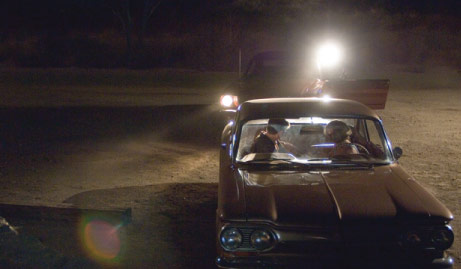 |
 |
From late December 1968 until early October 1969, a man who called himself “Zodiac” accounted for a brutal series of attacks and murders that baffled the combined police efforts in four Northern California counties. The perpetrator sent letters and ciphers to at least three Bay Area newspapers, brazenly taunting police and reporters like no other serial killer had since the infamous Jack The Ripper terrified Victorian London nearly a century before. As in the Ripper killings, the Zodiac was never caught. In his wake, careers were made and undone, and the lives of those obsessed with the notorious murders were dramatically changed, forever.
The movie, Zodiac, takes an unusual approach to a genre that its director, David Fincher, had already revolutionized a decade ago with the brilliantly dark-hearted Se7en. Based on two bestselling books (Zodiac and Zodiac Unmasked) by Robert Graysmith, a one-time political cartoonist at the San Francisco Chronicle who personally resurrected the investigation when the trail went cold, Zodiac is more about the living victims left in the wake of the most puzzling group of serial killings in American history than those done in by the mysterious sociopath. Fincher’s story covers several decades as it follows Graysmith (Jake Gyllenhaal) and his street-wise colleague at the Chronicle, crime reporter Paul Avery (Robert Downey, Jr.). It also tracks the San Francisco Police Department’s main detectives on the Zodiac case, Dave Toschi (Mark Ruffalo) and Bill Armstrong (Anthony Edwards). The lives of these men, all obsessed with solving the Zodiac crimes, intersect and spin off in surprising directions: Avery became undone by personal addictions and left the paper; Graysmith transformed his love for puzzles and ciphers into a new life as a true crime writer; Toschi (whose character inspired the films Dirty Harry, The Streets of San Francisco and Bullitt) fell from public grace when he was accused of authoring a Zodiac letter to revive his career; Armstrong left homicide detail when the evidence against the prime suspect, a Vallejo refinery worker named Arthur Leigh Allen, was never quite enough to procure a search warrant and arrest. Inevitably, Zodiac will be compared to Se7en. But a search for a serial killer is the only thing the two films share in common. Where Fincher’s earlier, fictional effort was set in an unnamed metropolis dripping with atmosphere and style, Zodiac’s palette is total restraint. Camera movement is kept to a minimum, and the wide-screen frame is filled with scrupulous attention to duplicating the real San Francisco Bay locations of thirty-plus years ago. As cinematographer Harris Savides, ASC, who shot the landmark credits for Se7en, notes about Zodiac’s clean and lean approach: “the story had so much expository information to get across. At every point in the process, we thought about clarity. How does this angle make the |
| |
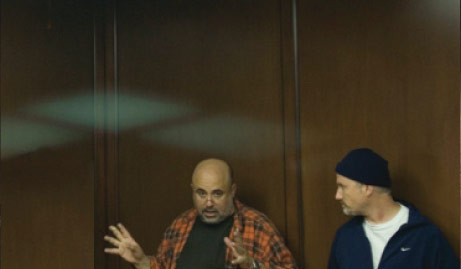 |
| DP Harris Savides, ASC says his working relationship with director David Fincher (right) was more facilitator than collaborator. In terms of feature films, they previously worked together on Fincher's The Game. |
|
story we’re telling more real for the audience?” In fact, the first Hollywood-backed feature shot entirely with the Thomson Viper FilmStream Camera, which Fincher previously used on commercials for Nike, HP, Heineken, Lexus, and Motorola, turns out to be more notable for its tapeless, High-Definition workflow than for any visual pyrotechnics. Savides, who used the Viper on Fincher’s Motorola spot, captured each day’s shooting as RAW data in the camera’s 10-bit, 4:4:4 full color space FilmStream mode, where information is pulled directly off the Viper’s three 2/3” HD sensor chips without compression. (The data coming off the Viper CCDs was 12-bit analog-digital, converted to RGB data values as logarithmic calculations, which were then output as 10-bit log values via a dual HD-SDI (SMPTE 372M) carrier.) The most notable application of the Viper prior to Zodiac was on Collateral, where cinematographer Dion Bebee used the Viper’s HD Stream mode, which employs in-camera processing to convert image data on the fly from uncompressed 4:4:4 color space to the more conventionally reduced color space of 4:2:2 used for tape media. Unlike the 4:4:4 mode, where full resolution is maintained through true progressive 1920/1080 pixels for each color, the Viper’s 4:2:2 mode uses some color processing and in-camera color balancing to achieve color temperatures of 3200K or 5600K.
THE STORY HAD SO MUCH EXPOSITORY INFORMATION TO GET ACROSS.
AT EVERY POINT IN THE PROCESS, WE THOUGHT ABOUT CLARITY. HOW DOES THIS ANGLE MAKE THE STORY WE’RE TELLING MORE REAL FOR THE AUDIENCE."
DP HARRIS SAVIDES, ASC |
What may be remembered about Zodiac is its media-free pipeline, which went where no movie had gone before: the RAW data captured in 1920/1080p HD format was cabled directly to on-set digital hard drive recording systems (called D.Mags), designed by S.two Corp. of Reno, Nevada. The D.Mags stored the raw data as DPX (Digital Picture Exchange) files, which allowed for greater color flexibility, and ease of delivery across different downstream platforms. In essence, the Viper’s FilmStream mode was like having a portable 10-bit log film scanner, equipped with a high-quality Zeiss lens, on the set. At the end of each day’s shooting, the D.Mags were shuttled to Zodiac’s editing facilities, where all the RAW data was backed up to two LTO (Linear Tape-Open) tapes, creating digital negatives with no compression or generational loss that were exact duplicates of what was captured on the set. One LTO was sent to Warner Bros.’ vault, the other remained in the editing suite to be rendered into DVCPRO HD QuickTime files, and loaded into an off-the-shelf Apple Final Cut Pro editing system. Once the RAW shooting data was checked and verified on each drive, the D.Mags were returned to the set for erasure and reuse. The overseer of RAW data capture was supervising engineer Wayne Tidwell, who managed the S.two hard drives on-set. Tidwell had worked as Fincher’s video assist on The Game, Fight Club, and Panic Room, as well as being the data capture engineer on the five commercials Fincher had previously shot with the Viper. Tidwell says the system was suited to the director’s style because it allowed Fincher to see full resolution instantly without any compression, typical in other digital systems destined for tape. Waiting for film dailies or lab reports was obviously not an issue; however there was initial concern about the hardiness of the digital field drives compared to the proven endurance of a 35mm camera system. Tidwell says he was surprised to find less down time, i.e., equipment failure, than normally seen on a film shoot. “All total we may have had one to one-and-a-half hours of lost time,” he explains. “Since there is no film gate to block up, negative to scratch, or even a |
| |
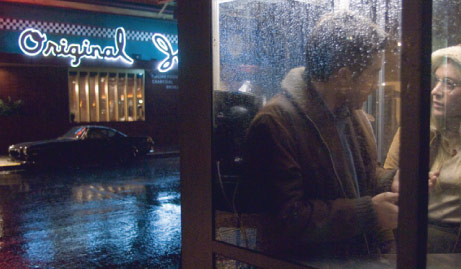 |
| |
| tape drive mechanism to worry about, those kinds of problems aren’t a concern.” Tidwell worked with S.two engineers to upgrade the hard drive technology to fit Fincher’s needs. The director wanted an auto-slate function built in, which saved as much as thirty minutes per day. He also wanted to monitor takes on the set, the D.Mags are specifically designed to prevent on-set image deletion. Fincher had the drives modified; when he disliked a take, he would simply delete the RAW data captured and move on.
Post-supervisor Peter Mavromates says the look of Zodiac was established with Savides, Fincher and Technicolor Digital Intermediates colorist Stephen Nakamura, in the months before production began, and it stayed consistent right on through the DI process. “I’d describe it as slightly lifted blacks with a dynamic range that harkens back to 1970s era movies, but certainly not without contrast,” notes Mavromates. The post-supervisor, who worked with Fincher and Savides on The Game, as well as on Fincher’s Fight Club and Panic Room, says Nakamura handled much of the digital intermediate process solo (Savides had a commitment to shoot another 70s era story, American Gangster, for Ridley Scott), with Fincher coming in at the end to do “subtle massaging and take it over the finish line.” Dailies were viewed by Fincher on a secure website, via the Internet-based PIX system (Project Information Exchange). But Mavromates says the main review of dailies actually occurred between Savides and Fincher on the set, where takes were essentially selected or deleted in-between lighting or camera set-ups. Since it is a secure Web-based platform, PIX allowed off-site entities, like department heads and studio executives, to see dailies from a remote location. “One of the things that was unique about Zodiac, versus other digital shows,” explains Mavromates, “is that the RAW data Harris captured on the set went directly to our editorial team. It never passed through dub houses, labs, or telecine, which was both a time and security benefit. Zodiac’s overall workflow came down to two places, the set and editorial. And that’s the type of control David Fincher wanted.” While the Viper offered an exciting new direction in the areas of image capture and post-production, it proved slightly more unpredictable with lighting. For a DP like Savides, accustomed to the full color space, broad contrast ratios, and sensitivity of 35mm film, as well as for having a masterful reputation in using natural, low-level, and practical light sources for directors like Gus Van Sant and Wong Kar Wai, the Viper was a mixed bag. Savides describes the current incarnation of digital cinematography as: “synthetic looking, like a Cibachrome still print that’s very plastic and silvery.” In order to recreate audience recollections of the 1970s, which predate digital capture, the DP says he tried to strip the Viper of its modern edge by pushing the camera’s limits. “We looked at still photographers like William Eggleston, Stephen Shore, and Todd Hido, who represent the color palette of that era,” notes Savides. The DP did not use look-up tables, which typically allow on-set color correction (without impacting raw data capture) to offset the flat, greenish cast of the FilmStream mode when viewed on a |
| |
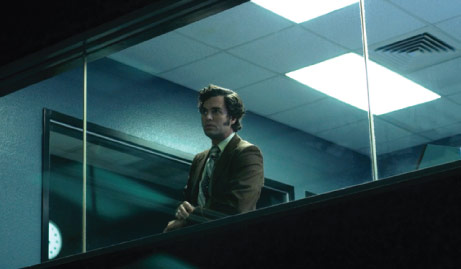 |
| |
dual-link 4:4:4 monitor. Through pre-production testing, Savides and Fincher arrived at a series of magenta filters to place in front of the Viper’s sensors, which made the image look “semi- normal,” in the words of Mavromates. “Not one hundred percent, but not nearly as flat and green as typical RAW digital capture.” Look-up tables were created from Savides’ pre-production testing, and used by Fincher to view dailies for roughly half the production. The DP says he never felt look-up tables were applicable for his goals with lighting. “I became very comfortable with the appearance of the RAW capture and began to really like it,” he chuckles.
Savides did rigorous pre-production testing on the Viper for highlight clippings and tolerance with deep blacks, much of Zodiac takes place outdoors at night, including many of the key murder scenes. Fully conversant with 35mm’s broad range (Kodak touts 10-12 stops for selected stocks), Savides was thrown off-balance by the Viper’s enigmatic qualities. Other than problems handling backlight, the Viper’s range was inconsistent and subject to experimentation. The DP used the proprietary Zeiss DigiPrimes. His complement ranged from a 5mm-T1.9 to a 70mm-T1.6 close focus. According to Savides, all the lenses performed well, looked great, and avoided flaring. But he was particularly impressed with the super-fast Zeiss 6-24mm-T1.9 digital zoom lens. Given the Viper’s anomalies during testing, Savides tossed aside his light meter once shooting began and worked from instinct. “The HD monitors were incredible. You’d see shadow and chromatic detail that you’d never see in NTSC or PAL,” he recounts. “But they tended to overcompensate in low light. Sometimes I felt like a Hazeltine operator trying to interpret how the digital technology saw what I had lit on the set.” Savides says that in retrospect, he may have gone too far in low-level lighting. “The Viper’s chip needs to be tickled and kept happy,” he laughs, “and some of the things I tried may have been better left to the full range of color manipulation available in digital post.” One example was a scene where Toschi and Armstrong go to interview famed personal injury attorney, Melvin Belli, who had received a hand-written Christmas card from the Zodiac in late December, 1969. Savides used separate close-ups on each investigator that were, in his words, “extremely dark.” He says because the location was crammed tight with equipment, he had to use bounced light off the dark-wood ceiling. “I was concerned we’d gone too far for the Viper and needed to see the scene projected,” he recalls. “I recently saw a finished digital screening, and I was happy with it. It’s hard to put into words, but the imagery is evocative, and makes you feel something.”
One location that was challenging for the Viper was the San Francisco Chronicle newsroom, built as a set in the old Post Office in the Terminal Annex Building in downtown Los Angeles. Given the location’s large expanse and need for wide-angle coverage, lighting had to be done from above. Savides did tests with various fluorescent bulbs to use inside of the existing fixtures. Shooting from mostly low angles, the Viper tended to “bloom” more than expected, but it wasn’t, as Savides noted, “a bad thing at all.” Other scenes, like when Graysmith visits possible suspect Rick Marshall’s basement at night, were filled with the type of creepiness we’ve come to expect from David Fincher. Savides says the scene was lit with practicals, augmented with incandescent bulbs in the back of the anamorphic frame to avoid spilling off into total blackness. Speaking of the wide-screen aspect ratio, one of the Viper’s strengths, according to a recent Web interview with Fincher, is the camera’s native ability with the 16 x 9 pixel array to give full use of the 1920/1080p across the 2:37:1 anamorphic aspect ratio. In his comments for Digital Content Producer.com, Fincher says he wanted to get as much resolution as possible, and did not want to crop the frame top to bottom. “Why start out with a 2K image, and then throw a third of the frame away?” asks the filmmaker. Savides says his working relationship with the notoriously meticulous director was more “facilitator than collaborator.” Although the DP admits he was “slightly in awe” of Fincher’s methods, his philosophy of lighting didn’t change for Zodiac. In fact, Savides’ less-is-more lighting schemes were a good match for a story that is so packed with exposition; the volume of pre-production research material alone could have filled ten times the 40 terabytes of hard drive space that occupied Zodiac’s post-production unit, led by editor Angus Wall. Savides says he prefers to light spaces that the characters can inhabit, rather than pick out actors within the frame. I always kept the instruments on Zodiac very simple, even for the exteriors.” |
| |
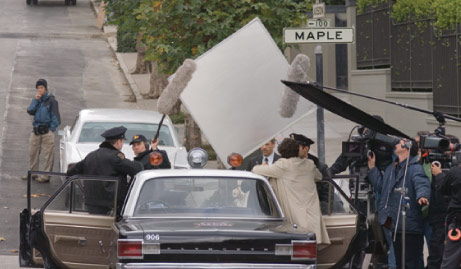 |
| |
A case in point was the film’s first deadly attack, on Darlene Ferrin and Michael Mageau in a Vallejo park, shortly after midnight on the fourth of July. Ferrin died on the way to the hospital. But Mageau survived the shootings, later identifying the man Robert Graysmith becomes convinced was the true Zodiac killer. “Once we had scouted the location and knew how the scene was going to develop,” Savides describes, “with the boy and girl parked in the car, and the killer driving in toward them, I asked for a single lamp post that would help motivate the lighting. It’s dark, it’s late, and the spot is known as a place for kids to go make out, so there wasn’t any need to push the motivation beyond what existed. We did have to bring the light down when we did some of the closer shots on the girl in the car. But otherwise it was mostly just using open-faced fixtures, like blondes and redheads with 1/4 CTO that was enough to do the trick.” Savides says his minimal use of instruments, for a scene in Arthur Leigh Allen’s trailer, he lit through the windows using HMIs bounced into gryflon as skylight, and smaller HMI units, which were used as a hard, directional light, would occasionally raise eyebrows with the Viper’s imaging technicians. “But I just kept doing what came naturally until I got called into the principal’s office,” he laughs. (One point of note: Fincher wanted to extend the emotional time of the Blue Rock Springs murder scene with high-speed VFX. Digital high speed without compression was not yet available, so Savides tested the VFX with both the Viper and 35mm, taking the two formats through the pipeline and getting a 98% match. The VFX took up 10 seconds of screen time, and was ultimately shot by Savides on Kodak 5229. Mavromates delivered negative to Digital Domain, which sent back DPX files that dropped in seamlessly to the tapeless post flow.)
The last killing attributed to the Zodiac was the murder of a San Francisco cabdriver in a wealthy neighborhood near the Presidio. The murder was actually witnessed by three teenage siblings from their 2nd floor window directly across the street from the cab. They saw the Zodiac cut away a swath of the victim’s bloody shirt, wipe down parts of the cab’s interior and exterior, and then casually saunter away. Amazingly, the same family still lives in the Presidio Heights brownstone, and they wanted no part of reliving the tragic events. So the Zodiac team recreated the Washington and Cherry exterior in Los Angeles as a built location. The scene begins with Toschi and Armstrong approaching in their squad car, accounting for the only two shots that don’t have a digital effects component: one side of the street was shot by Savides in San Francisco, the remainder was recreated as a massive multi-block artificial set. Curbs were built with the taxicab nearby, and building facades, one for behind the cab, the other, for where the children gaze out of their window, were constructed. Complicating matters was Fincher’s desire to have the scene shot handheld. “We used blue screens as the actors moved around the cab,” Savides recalls. “The effects people from Digital Domain went up to San Francisco and used photo mapping to replace the other side of the street and both intersections. It was an amazing way to execute a night exterior where an entire street location is shown in frame, and the camera is moving. I’m sure most other filmmakers would have just locked off the camera to allow for the digital replacement.”
Amazing, complex, unprecedented, these terms have been bandied about when describing David Fincher’s use of the Viper’s media-free workflow on Zodiac. In truth, what made the process so unique was the amount of talented creative people used to harness a technology that has, up until this point, been mostly the domain of engineers. Still, it is ironic to note that the Zodiac’s claim to fame was his obsession with intricate strings of ciphers and codes, only one of which was ever cracked (within a week of its publication by a Salinas high school teacher); much of Fincher’s methodology in using the Viper’s raw data capture has been considered equally mystifying, those unable to “crack the code,” consider the workflow overly convoluted when compared to 35mm. Harris Savides says the rewards about working with the Viper have to be put into perspective. “The benchmark for me has always been film, and this was a more challenging way to make a movie,” Savides concludes. “I feel like we’re still experiencing digital cinematography in its infancy, and there are a lot of growing pains. We’re basically replacing large, cumbersome film cameras and crews with even more complex and cumbersome digital technology, with results that are roughly equal to, or in some cases, not as good as film. If this technology leads to the creation of a more flexible and streamlined shooting process, then that would be great. If I was part of that change with Zodiac then that would be great.” |
|
 |
|
|
 |
|
|
 |